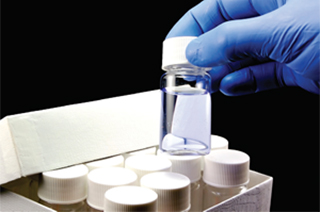Introduction

What is hexavalent chromium?
Hexavalent chromium is a form of the metallic element chromium. Chromium is a naturally occurring element found in rocks, animals, plants, soil, and volcanic dust and gases. It comes in several different forms, including trivalent chromium and hexavalent chromium. Trivalent chromium is often referred to as chromium (III) and is proposed to be an essential nutrient for the body. Hexavalent chromium, or chromium (VI), is generally produced by industrial processes.
How is hexavalent chromium used?
Chromium compounds, such as hexavalent chromium, are widely used in electroplating, stainless steel production, leather tanning, textile manufacturing, and wood preservation. The U.S. is one of the world's leading producers of chromium compounds.
How are people exposed to hexavalent chromium?
Hexavalent chromium exposure occurs through breathing it in, ingesting it in food or water, or direct contact with the skin.
What are the known health effects of inhaling hexavalent chromium?
Hexavalent chromium compounds have been shown to cause lung cancer in humans when inhaled.
The Report on Carcinogens lists hexavalent chromium compounds as known human carcinogens. Studies have consistently shown increased lung cancer rates in workers who were exposed to high levels of chromium in workroom air.
People who work in industries that process or use chromium or chromium compounds can be exposed to higher-than-normal levels of chromium. Occupational exposures occur mainly among workers who handle chromate-containing pigments, spray paints, or coatings; operate chrome plating baths; or weld or cut metals that contain chromium, such as stainless steel. Some of the adverse health effects from hexavalent chromium exposures include nasal and sinus cancers, kidney and liver damage, nasal and skin irritation and ulceration, and eye irritation and damage.
Are there safety levels for exposure to chromium in drinking water?
The U.S. Environmental Protection Agency (EPA) has set a maximum contaminant level of 100 parts per billion for total chromium in drinking water. Numerous states have established limits of 50 parts per billion of total chromium in drinking water.
What can I do to prevent exposure of my family to hexavalent chromium?
Work with your public health officials to determine if hexavalent chromium is present in your environment, such as water, air, and soil, and at what levels, particularly if you live near a site where chromium compounds are disposed of or manufactured. Children should avoid playing in soils near uncontrolled hazardous waste sites where chromium may have been discarded.
Limit occupational exposure to hexavalent chromium compounds. The Occupational Safety and Health Administration (OSHA) established a hexavalent chromium standard that protects employees from chromium exposure risks, such as lung cancer, skin ulcers, and dermatitis.
What prompted the National Toxicology Program (NTP) to study hexavalent chromium?
Hexavalent chromium was detected in groundwater samples in California and other states. There was public concern about the safety of the drinking water in several California cities. Hexavalent chromium was brought to the public's attention in many ways, most notably in the movie "Erin Brockovich."
The California congressional delegation, California Environmental Protection Agency, and California Department of Health Services nominated hexavalent chromium for toxicity and carcinogenicity testing, because of concerns over its presence in drinking water sources, its potential health effects including causing cancer, and the lack of adequate cancer studies on ingested hexavalent chromium. Hexavalent chromium compounds have been shown to cause lung cancer in humans when inhaled, but it was not known whether these compounds could also cause cancer when ingested.

What do NTP studies say about hexavalent chromium in drinking water?
The National Toxicology Program (NTP) studies show that sodium dichromate dihydrate, a compound containing hexavalent chromium, causes cancer in laboratory animals following oral ingestion. Researchers found significant increases in tumors at sites where tumors are rarely seen in laboratory animals. Male and female rats had malignant tumors in the oral cavity. The studies conducted in mice found increases in the number of benign and malignant tumors in the small intestine, which increased with dose in both males and females.

Where can I find out more about hexavalent chromium?
All NTP data and reports are available on the NTP website.
Other resources include:
Further Reading
Stories from the Environmental Factor (NIEHS Newsletter)
- RIVER Grantee Examines Chromium Exposure Consequences Across Species (September 2024)
- Environmental Epigenetics Uncovers Links Between Exposures, Disease (May 2022)
Additional Resources
- NIOSH Hexavalent Chromium - Workplace safety and health information from the National Institute for Occupational Safety and Health of the Centers for Disease Control and Prevention, U.S. Department of Health and Human Services.
- OSHA Hexavalent Chromium - Information for workers from the Occupational Safety and Health Administration, U.S. Department of Labor.
Related Health Topics
This content is available to use on your website.
Please visit NIEHS Syndication to get started.

